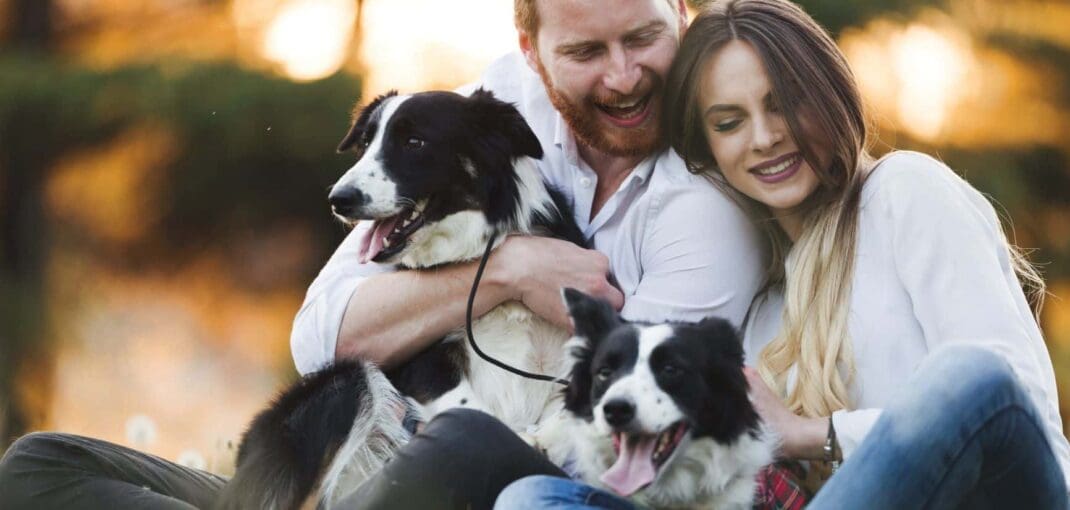
Two dogs in a home is certainly a lucky thing for a carer. For every dog, the purpose of life is to be with a human, whereas not every dog dreams of a companion on four paws. Dogs behave differently with each other than they do with humans. They have different characters and different experiences, so life under a common roof is a clash of different temperaments and needs.
Two dogs at home – choosing a breed
Dog lovers decide to get a second four-legged dog for a variety of reasons, it could be, for example, a fascination with the breed. They find that a pet of their favourite breed is fantastic and it is worth getting them a companion. Such a situation has a good chance of success. Specific breeds tend to have similar needs when it comes to meeting needs. If we have two Great Danes, we try to satisfy their hunting instinct and an adequate dose of exercise. On the other hand, if you have two Labradors, it is worth setting aside plenty of time for play and exercise. Two ornamental and companion dogs can spend more time with us on the sofa.
With such a match, we do most things together. However, there may be a circumstance where we have two dog breeds whose potentials are very different. For example, a German Shepherd and a Mops. The German Shepherd needs new challenges, training, working with a handler, he hates boredom. He needs to have a long walk once a day to use up his energy. The Mops belongs to the brachycephalic breeds, which means it has a short muzzle. He can’t strain himself and run long distances. So shared walks can be the shorter ones, which means the carer has to find more time for extra activities.
Different dogs’ needs
Sometimes the motivation for taking on a second dog is to provide companionship for the first one, so that it has someone to play with while the carers are away. This does not always work. Dogs have a strong need to be with another human, but not necessarily with a second mate. It can happen that dogs, when alone, ignore each other, and get bored together while waiting for a carer. Each dog needs to be alone with its handler for the handler to give it exclusive attention. Exercises are also usually done separately, because when playing together, rewarded with treats, the dogs tend to compete with each other. We should not assume by taking on a second dog that it will have the same needs. By matching the expectations of one dog to another, you may neglect one friend on four paws.
Observing the dogs
With any duo dog, the most important rule of thumb is to observe in which situations they feel safe and in which they feel uncomfortable. When living together, it is important to keep these conclusions in mind and always try to follow the needs of your charge. This will allow you to create a world for him in which he feels safe. And this means that we will not have parenting problems with him. A dog that is not comfortable is frustrated and lives under stress. He may exhibit undesirable behaviour, become withdrawn and start to feel anxious.
Two dogs are usually a double task. Each usually falls ill at different times. The number of visits to the vet can be twice as many. Two dogs may age at different times. So while one will still be at full health, the other will require special care from the carer.
Adopting a second dog
Many people decide to get a second dog for emotional reasons because they want to give a home to a homeless dog from a shelter. This is a wonderful gesture considering how many dogs in shelters are waiting for responsible carers. A dog in a shelter or foundation is very anxious to have a personal guardian. The staff, volunteers or people in temporary homes are familiarising him in terms of his future life with his human. When he finds himself in a target home with a second dog he is able to adapt to the situation, rarely competing with the first householder on four paws. The shelter pooch is very focused on building a strong bond with its handler and is often not interested in interacting with the dog that came before. This may be because he didn’t learn how to play and bond with other dogs when he was a puppy, so he just doesn’t have that need. You can try to encourage the dogs to play together, but if they are not interested, you have to accept that they will just tolerate each other. They will each get their dose of love from their guardians.
How do you get dogs acquainted with each other?
If you decide to bring a new dog with you, it is better for them to get to know each other on neutral ground beforehand. In the case of adoptions from a shelter, special pre-adoption walks are organised for this purpose in order for the dogs to get to know each other. If a second dog is brought in, it is better for the first one to get to know him beforehand and for them to enter the house together.
Each dog should have its own bedding and a separate bowl. From the first day the second dog is in the house, it is worth remembering that our four dogs must be treated fairly, that is, each is to get the same amount of attention and affection. This includes eating, giving treats, sleeping in bed, stroking, playing, exercising, walking and many other situations that are a dog’s home routine. This means that we cannot favour one dog over another.
Before deciding on a second dog, it is worth considering whether the arrival of a new companion on four paws will be too much of a shock for your current pet. Usually, dogs living in large families with children tolerate a new family member on four paws better. The situation can be more difficult with a dog that permanently lives with one person. Then a very strong bond centred on the carer is formed.
The dogs will establish the rules of the pack among themselves, the carer should observe this from the sidelines and, if there is no aggressive behaviour, try not to interfere. It is equal treatment, without singling out any pup, that will help them build a correct relationship with each other.






